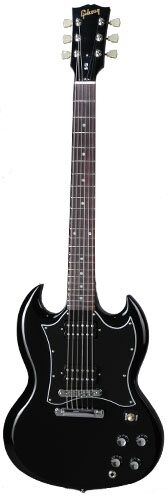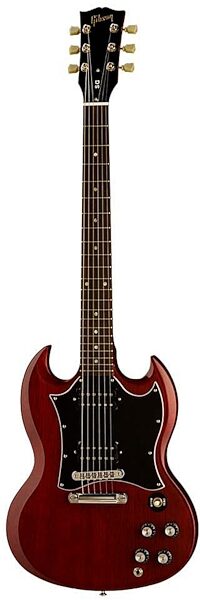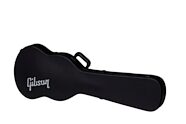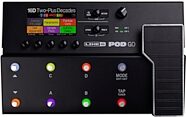Gibson SG Special Electric Guitar (with Gig Bag)
No longer available at zZounds







Get the sound you've been looking for with the Gibson SG Special. The SG Special features Gibson's renowned nitrocellulose finish.
Overview
The original Gibson SG shattered all perceptions of what a guitar should be when it was first introduced in 1961. Today, the SG stands as one of Gibson's most popular and best-selling guitars. Its distinct twin cutaways, pointed horns, and beveled edges have made it one of the most inspired and iconic designs in the history of guitar making.
Nitrocellulose Finish
Applying a nitrocellulose finish to any Gibson guitar is one of the most labor-intensive elements of the guitar-making process. A properly applied nitro finish requires extensive man hours, several evenly applied coats, and an exorbitant amount of drying time. But this fact has never swayed Gibson into changing this time-tested method, employed ever since the first Gibson guitar was swathed with lacquer back in 1894. Why? For starters, a nitro finish dries to a much thinner coat than a polyurethane finish, which means there is less interference with the natural vibration of the instrument, allowing for a purer tone. A nitro finish is also a softer finish, which makes it easily repairable. You can touch up a scratch or ding on a nitro finish, but you can't do the same on a poly finish. In addition, a nitro finish is very porous in nature, and actually gets thinner over time. It does not "seal" wood in an airtight shell--as a poly finish does--and allows the wood to breathe and age properly.Angled Headstock
The angled headstock is another example of Gibson's industry-changing way of thinking. Every Gibson… read more headstock is carved out of the same piece of mahogany as the neck then fitted with Gibson's traditional wing blocks. It is not a "glued-on" headstock, and the process takes craftsmanship, time, and effort. But the rewards are worth the effort. The headstock is carefully angled at 17 degrees, which increases pressure on the strings and helps them stay in the nut slots. An increase in string pressure also means there is no loss of string vibration between the nut and the tuners, which equals better sustain.Truss Rod
The adjustable truss rod is a Gibson innovation that revolutionized the guitar. Before this ground-breaking discovery in the early 1920s, the truss rod was used only to strengthen and stabilize the neck. By making it adjustable, the truss rod now allows a guitar to be set up using a variety of string gauges, as well as string heights. This easily accommodates any style of playing, and allows a limitless range of set-up options. And by placing it at the base of the headstock, the adjustable nut is easily accessible, even while the strings are still on the guitar.'50s Rounded Neck Profile
No guitar neck profiles are more distinguishable than the neck profiles employed on the Gibson models of today. The more traditional '50s neck profile on the SG Special is the thicker, rounder profile, emulating the neck shapes found on the iconic 1958 and 1959 Les Paul Standards. The neck is machined in Gibson's rough mill using wood shapers to make the initial cuts. But once the fingerboard gets glued on, the rest--including the final sanding--is done by hand. That means there are no two necks with the exact same dimensions. So while it still has the basic characteristics of its respective profile, each neck will be slightly different, with a distinct but traditional feel.22-Fret Rosewood Fingerboard
Rosewood has always graced the fingerboards of the world's finest stringed instruments, including many of today's Gibsons. The fingerboard on the Gibson SG Special is constructed from the highest grade rosewood on the planet. The rosewood is personally inspected and qualified by Gibson's team of skilled wood experts before it enters the Gibson factories to be fitted onto the necks of the SGs. The resilience of this dense and durable wood makes these fingerboards extremely balanced and stable, and gives each chord and note unparalleled clarity and bite. The 12-inch radius of the fingerboard provides smooth note bending capabilities and eliminates "dead" or "choked out" notes, common occurrences on fingerboards with lesser radiuses.Nickel and Silver Alloy Fret Wire
The fret wire on the Gibson models is a combination nickel and silver alloy (approximately 80 percent nickel and 20 percent silver) specifically designed for long life and superior wear. Gibson's traditional "medium/jumbo" fret wire is first shaped by hand, then cut to an exact 12-inch radius. After hand pressing it into the fingerboard, a machine press finishes the job to eliminate the gap between the bottom of the fret wire and the fingerboard.Dot Inlays
Over the years, the classic dot inlay has been one of the more traditional features of many Gibson models, including the SG. A figured, swirl acrylic gives these inlays that classic "pearl" look. They are inserted into the fingerboard using a process that eliminates gaps and doesn't require the use of fillers.Set-Neck Construction
Like all classic Gibson guitars, the necks on SG Specials are distinguished by one of the more traditional features that have always set them apart--a glued neck joint. Gluing the neck to the body of the guitar ensures a "wood-to-wood" contact, no air space in the neck cavity, and maximum contact between the neck and body, allowing the neck and body to function as a single unit. The result? Better tone, better sustain, and no loose or misaligned necks.Solid Mahogany Body
Probably the most central of all the SG Special's features is its solid mahogany body--lightweight, strong, with a thick, warm tone. The mahogany goes through the same rigorous selection process as all of Gibson's woods, and is personally inspected and qualified by Gibson's team of skilled wood experts before it enters the Gibson factories. Inside the Gibson factories, humidity is maintained at 45 percent, and the temperature at 70 degrees. This ensures all woods are dried to a level of "equilibrium," where the moisture content does not change during the manufacturing process. This guarantees tight-fitting joints and no expansion, in addition to reducing the weight. It also helps with improving the woods' machinability and finishing properties. Consistent moisture content means that a Gibson guitar will respond evenly to temperature and humidity changes long after it leaves the factory.490 (R) Rhythm and (T) Treble Pickup
The mid to late 1960s saw the emergence of a very different type of music coming from the clubs of England. It was an interpretation of the blues that hadn't been heard before, and it was much harder, more rocking, and definitely louder than anything else before it. As such, this new genre's players were demanding more powerful amplifiers with increased volume outputs to satisfy their sonic explorations. This led to a call for a more versatile pickup that could split coils through a push/pull knob, and prevent microphonic feedback from occurring when the volumes were turned up to maximum levels. Gibson answered this call with the introduction of the revolutionary 490T and 490R pickups ("T" for treble, and "R" for rhythm), which has the traditional characteristics of the original "Patent Applied For" pickups, but with two key modifications. First, a four-conductor wiring scheme allows the 490s to be connected to any push/pull knob, which lets players split the coils and increase versatility. Gibson also introduced wax potting, which does away with any air space, minimalizing microphonic feedback. The 490R is a humbucker with the tonal characteristics of an original PAF, with a slight increase in upper mid-range response. The 490T bridge pickup is calibrated to match the 490R, with pole pieces aligned a little further apart to accommodate the spacing of the strings at the bridge, which is different than the spacing of the strings at the neck. And,Tune-O-Matic Bridge
The Tune-o-matic bridge was the brainchild of legendary Gibson president Ted McCarty in 1954. At the time, it was a true revelation in intonation, and set a standard for simplicity and functionality that has never been bettered. This pioneering piece of hardware provides a firm seating for the strings, allowing the player to adjust and fine-tune the intonation and string height in a matter of minutes. It also yields a great union between the strings and body, which results in excellent tone and sustain. It is combined with a separate "stopbar" tailpiece, essentially a modified version of the earlier wraparound bridge. To this day, the Tune-o-matic remains the industry standard. It is the epitome of form and function in electric guitar bridge design, and is one of the most revered and copied pieces of guitar hardware ever developed. read lessSpecs
- Body: Mahogany
- Neck/Profile: Mahogany
- Fingerboard/Inlay: Rosewood/Dot
- Scale/Nut Width: 24-3/4 in./1-11/16 in.
- Bridge/Tailpiece: Tune-o-matic/Stop bar
- Hardware: Chrome (Gold on Cream finish)
- Pickups: 490R Alnico magnet humbucker, 490T Alnico magnet humbucker
- Controls: 2 volume, 2 tone, 3-way switch
- Strings: Brite Wires .009-.042
- Neck/Profile: Mahogany
- Fingerboard/Inlay: Rosewood/Dot
- Scale/Nut Width: 24-3/4 in./1-11/16 in.
- Bridge/Tailpiece: Tune-o-matic/Stop bar
- Hardware: Chrome (Gold on Cream finish)
- Pickups: 490R Alnico magnet humbucker, 490T Alnico magnet humbucker
- Controls: 2 volume, 2 tone, 3-way switch
- Strings: Brite Wires .009-.042
Reviews
Reviewers gave this product an overall rating of 5 out of 5 stars.
(234 ratings)
Submitted July 22, 2010 by a customer from charter.net
"Nice addition to my collection."
Verified Customer
zZounds has verified that this reviewer made a purchase from us.
I'm sure this will not be my last guitar, it fits what I was wanting to to with the sound. I would replace with the same. Now I was a bit suprised as I bought a new Gibson SG but the guitar was made in December 2008 so it is over 18 months old. A bit of a surprise but I can deal with it.
Sound
It's a Gibson!. That should explain the sound but to say more, the Bridge pickup is crisp as a Humbucker should be. I used my Marshall Bluesbreaker to test. The Neck pickup gives the blues tone I favor. Volume and Tone controls are smooth as expected for a Gibson. Combining both you can dial in a nice overdrive.
Features
Came with a Gig bag and warranty card only. If I was to rate only the gig bag it would be a 2. Mine came with a broken zipper. The bag protected the SG very well during shipping so I should be happy with that. I purchased a hard case ahead of time as I hate gig bags but I would think for the money it should at least be in good condition. But the guitar is perfect so a combination of 9. I also bought pickup covers which I will install. I like my pickups covered as I use my guitars and all the sweat, beer and dust is just too hard to get out of the exposed tape in the pickups.
Ease of Use
I love Gibsons. I also have a Les Paul Standard. So different. The SG has a 50's neck, I was not sure I would like but it's really comfortable to play. The Horned cutout allows you to reach every… read more fret. Tone I rated before the sound variables are amazing. Can't go wrong with this guitar.
Quality
The SG finish is perect not an problem anywhere. Nothiing like a Gibson finish. I use but don't abuse. I had to get a hard case too many possibilities to damage while out gigging. The Gig Bag again came damaged so quality wise for it is a 2.
Value
For the price it should have came with a case. But I am glad the money went to the quality of the guitar, which again is perfect. Compared to an American Stratocaster both about equal in price, that came with a hard SKB Case when I bought. But sound wise they are very different, I like both in their own way.
Manufacturer Support
Well ZZOUNDS can't correct the gig bag situation and I contacted Gibson whom I never used in the 40 years I've been playing. So far I haven't received a call back (only been a day and a half)as I had to leave a message for a return call. We shall see what happens when the attempt to correct. I assume the best I can hope for is a new gig back which I would not use anyway.
The Wow Factor
This guitar gets attention. Fits in with my collection of guitars. Very different from my Les Paul but both a fine quality instrument.
Musical Background:
Active Musician
Musical Style:
Blues Classic Rock read less
Sound
It's a Gibson!. That should explain the sound but to say more, the Bridge pickup is crisp as a Humbucker should be. I used my Marshall Bluesbreaker to test. The Neck pickup gives the blues tone I favor. Volume and Tone controls are smooth as expected for a Gibson. Combining both you can dial in a nice overdrive.
Features
Came with a Gig bag and warranty card only. If I was to rate only the gig bag it would be a 2. Mine came with a broken zipper. The bag protected the SG very well during shipping so I should be happy with that. I purchased a hard case ahead of time as I hate gig bags but I would think for the money it should at least be in good condition. But the guitar is perfect so a combination of 9. I also bought pickup covers which I will install. I like my pickups covered as I use my guitars and all the sweat, beer and dust is just too hard to get out of the exposed tape in the pickups.
Ease of Use
I love Gibsons. I also have a Les Paul Standard. So different. The SG has a 50's neck, I was not sure I would like but it's really comfortable to play. The Horned cutout allows you to reach every… read more fret. Tone I rated before the sound variables are amazing. Can't go wrong with this guitar.
Quality
The SG finish is perect not an problem anywhere. Nothiing like a Gibson finish. I use but don't abuse. I had to get a hard case too many possibilities to damage while out gigging. The Gig Bag again came damaged so quality wise for it is a 2.
Value
For the price it should have came with a case. But I am glad the money went to the quality of the guitar, which again is perfect. Compared to an American Stratocaster both about equal in price, that came with a hard SKB Case when I bought. But sound wise they are very different, I like both in their own way.
Manufacturer Support
Well ZZOUNDS can't correct the gig bag situation and I contacted Gibson whom I never used in the 40 years I've been playing. So far I haven't received a call back (only been a day and a half)as I had to leave a message for a return call. We shall see what happens when the attempt to correct. I assume the best I can hope for is a new gig back which I would not use anyway.
The Wow Factor
This guitar gets attention. Fits in with my collection of guitars. Very different from my Les Paul but both a fine quality instrument.
Musical Background:
Active Musician
Musical Style:
Blues Classic Rock read less
10 of 10 people (100%) people found this review helpful. Did you?
Thanks for your opinion!
No longer available at zZounds
In most cases, a product is unavailable because it has been discontinued by the manufacturer
This is a carousel with product cards. Use the previous and next buttons to navigate.
Cases and Bags
This is a carousel with product cards. Use the previous and next buttons to navigate.
Cases and Bags
This is a carousel with product cards. Use the previous and next buttons to navigate.















